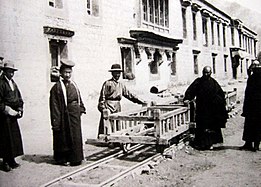
Dalai Lama is a title given by the Tibetan people to the foremost spiritual leader of the Gelug or "Yellow Hat" school of Tibetan Buddhism, the newest and most dominant of the four major schools of Tibetan Buddhism. The 14th and incumbent Dalai Lama is Tenzin Gyatso, who lives in exile as a refugee in India. The Dalai Lama is also considered to be the successor in a line of tulkus who are believed to be incarnations of Avalokiteśvara, the Bodhisattva of Compassion.

The Potala Palace is a dzong fortress in Lhasa, capital of the Tibet Autonomous Region in China. It was the winter palace of the Dalai Lamas from 1649 to 1959, has been a museum since then, and a World Heritage Site since 1994.
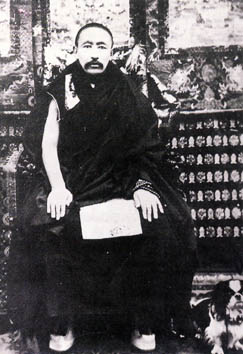
Thubten Choekyi Nyima (1883–1937), often referred to as Choekyi Nyima, was the ninth Panchen Lama of Tibet.

Ngawang Lobsang Thupten Gyatso Jigdral Chokley Namgyal, abbreviated to Thubten Gyatso was the 13th Dalai Lama of Tibet, enthroned during a turbulent era and the collapse of the Qing Dynasty. Referred to as "the Great Thirteenth", he is also known for redeclaring Tibet's national independence, and for his reform and modernization initiatives.

Kelzang Gyatso, also spelled Kalzang Gyatso, Kelsang Gyatso and Kezang Gyatso, was the 7th Dalai Lama of Tibet, recognized as the true incarnation of the 6th Dalai Lama, and enthroned after a pretender was deposed.
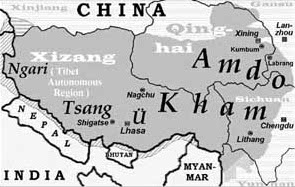
Ü-Tsang is one of the three Tibetan regions, the others being Amdo in the north-east, and Kham in the east. Ngari in the north-west was incorporated into Ü-Tsang. Geographically Ü-Tsang covered the south-central of the Tibetan cultural area, including the Brahmaputra River watershed. The western districts surrounding and extending past Mount Kailash are included in Ngari, and much of the vast Changtang plateau to the north. The Himalayas defined Ü-Tsang's southern border. The present Tibet Autonomous Region corresponds approximately to what was ancient Ü-Tsang and western Kham.
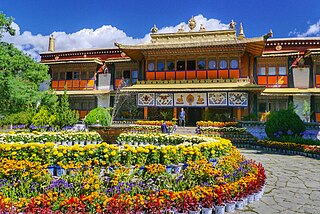
Norbulingka is a palace and surrounding park in Lhasa, Tibet, built from 1755. It served as the traditional summer residence of the successive Dalai Lamas from the 1780s up until the 14th Dalai Lama's exile in 1959. Part of the "Historic Ensemble of the Potala Palace", Norbulingka is recognized as a UNESCO World Heritage Site, and was added as an extension of this Historic Ensemble in 2001. It was built by the 7th Dalai Lama and served both as administrative centre and religious centre. It is a unique representation of Tibetan palace architecture.

Reting Rinpoche was a title held by abbots of Reting Monastery, a Buddhist monastery in central Tibet.
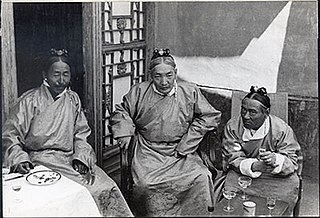
Trimön Shap-pe born Norbu Wangyal (1874–1945) was a highly prominent Tibetan aristocrat, conservative politician and governor, a former Finance Minister, and Chief Cabinet Minister of Tibet.. Trimon accompanied Regent Reting who jointly spearheaded the search to lake Lhamo Latso, leading to the discovery of Tenzin Gyatso, the 14th Dalai Lama in 1935. Trimon is regarded as an eminent personality and significant political figure in modern Tibetan history.

Tsepon Wangchuk Deden Shakabpa was a Tibetan nobleman, scholar, statesman and former Finance Minister of the government of Tibet.

Tsarong Dasang Dramdul (1888–1959), commonly known mononymously as Tsarong or by his title Tsarong Dzasa, was a Tibetan politician and general in the Tibetan Army. He was a close aide of the 13th Dalai Lama and played an important role in the early twentieth century politics of Tibet. Eager to accelerate economic progression and pursue the modernization of Tibet, Tsarong believed that the old order in Tibet had to be broken by hierarchical reforms to prepare the way for a more modern society which would be compatible with the outside world. In his efforts to build up Tibet's defense systems and relations with European powers as well as to facilitate trade and strengthen the Tibetan currency, he made a series of diplomatic visits to British India. His diplomatic skills came to see him regarded by the British as being, "the most powerful friend of His Majesty's Government in Tibet"

Tibet was a country in East Asia that lasted from the collapse of the Manchu-led Qing dynasty in 1912 until its annexation by the People's Republic of China in 1951.

(Thubten) Jamphel Yeshe Gyaltsen or Thupten Jampel Yishey Gyantsen, was a Tibetan tulku and the fifth Reting Rinpoche.

The Battle of Chamdo occurred from 6 to 24 October 1950. It was a military campaign by the People's Republic of China (PRC) to take the Chamdo Region from a de facto independent Tibetan state. The campaign resulted in the capture of Chamdo and the annexation of Tibet by the People's Republic of China.

The Tibet Improvement Party was a nationalist, revolutionary, anti-feudal and pro-Republic of China political party in Tibet. It was affiliated with the Kuomintang and was supported by mostly Khampas, with the Pandatsang family playing a key role.

Pandatsang Rapga was a Khampa revolutionary during the first half of the 20th century in Tibet. He was pro-Kuomintang and pro-Republic of China, anti-feudal, anti-communist. He believed in overthrowing the Dalai Lama's feudal regime and driving British imperialism out of Tibet, and acted on behalf of Chiang Kai-shek in countering the Dalai Lama. He was later involved in rebelling against communist rule.
The 1934 Khamba rebellion was a rebellion in the western regions of Kham in Xikang against the Tibetan Government and the Sichuan Warlord Liu Wenhui. It consisted of Khamba tribesmen led by the Pandatsang family; two brothers of the family, Pandatsang Togbye and Pandatsang Rapga, led the revolt.
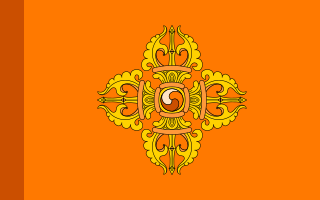
The Tibetan Army was the armed forces of Tibet from 1913 to 1959. It was established by the 13th Dalai Lama shortly after he proclaimed the independence of Tibet in 1912, and was modernised with the assistance of British training and equipment. It was dissolved by the Chinese government following the failed 1959 Tibetan uprising.

The Ganden Phodrang or Ganden Podrang was the Tibetan system of government established by the 5th Dalai Lama in 1642, after the Oirat lord Güshi Khan who founded the Khoshut Khanate conferred all temporal power on the 5th Dalai Lama in a ceremony in Shigatse in the same year. Lhasa again became the capital of Tibet, and the Ganden Phodrang operated until the 1950s. The Ganden Phodrang accepted China's Qing emperors as overlords after the 1720 expedition, and the Qing became increasingly active in governing Tibet starting in the early 18th century. After the fall of the Qing empire in 1912, the Ganden Phodrang government lasted until the 1950s, when Tibet was annexed by the People's Republic of China. During most of the time from the early Qing period until the end of Ganden Phodrang rule, a governing council known as the Kashag operated as the highest authority in the Ganden Phodrang administration.

Tibet under Qing rule refers to the Qing dynasty's rule over Tibet from 1720 to 1912. The Qing rulers incorporated Tibet into the empire along with other Inner Asia territories, although the actual extent of the Qing dynasty's control over Tibet during this period has been the subject of political debate. The Qing called Tibet a fanbu, fanbang or fanshu, which has usually been translated as "vassal", "vassal state", or "borderlands", along with areas like Xinjiang and Mongolia. Like the preceding Yuan dynasty, the Manchus of the Qing dynasty exerted military and administrative control over Tibet, while granting it a degree of political autonomy.


